Overview of the Brilliant grape variety - characteristics, description and cultivation features
In the absence of experience in viticulture, it is recommended to choose varieties with good immunity, unpretentiousness to soil and weather conditions. The Brilliant grape variety meets these criteria.
What is this grade
This is a variety of domestic selection, bred by the Novocherkassk VNIIViV in 2005. The varieties Victoria and Original White were used as the starting material.
Characteristics and description
Shiny refers to hybrid forms of grapes. The growing season is 95-100 days. The ripening period of the fruits occurs in the second half of July or early August.
The main characteristics of the plant:
- vigorous bushes;
- large space is required for planting;
- fruiting is observed from 2-3 years after planting the cuttings;
- the vine needs regular pruning (up to 6 eyes are cut from the shoot to increase yield);
- the leaves are large, saturated green with light veins.
The fruits are not pronounced conical in shape. Average weight - 7-8 g. When ripe, the color of the berry can be green or tinted pink. The tonality changes as the bunch is exposed to direct sunlight.
The pulp is characterized by moderate density and high taste, which the tasters estimate at 8.9 points (this is a high score). The table variety is appreciated for its balanced sugar and acid content, as well as its pleasant nutmeg aroma.
Reference! Shiny grapes do not crack in heavy rains. However, due to the thin skin, the presentation is lost during transportation.
One of the main advantages of Shiny is strong immunity, which can be traced in its high resistance to common diseases:
- oidium;
- mildew and other fungal infections.
The plant tolerates frost without loss of vitality when the temperature drops to minus 23 ° -24 °. If the winter is more severe in the region, then in the fall the vine is wrapped with covering material or simply added dropwise.
Productivity from a bush
The weight of a record cluster of an adult plant reaches 2.15-2.5 kg. This is despite the fact that the size and color of the berries may vary significantly. Average hand weight - 600-800 g.
More than 5 kg of fruits are removed from one bush. When grown in regions with a harsh climate, the weight of the record brush does not exceed 1.2 kg, the average bunch weighs 350-450 g.
Advantages and disadvantages
Variety Shiny - popular among gardeners. The grapes of domestic selection were recognized due to the following qualities:
- early maturity;
- strong immunity, resistance to common diseases;
- undemanding to the composition of the soil;
- high tasting score;
- large brushes;
- berries do not crack after prolonged rains;
- frost resistance (up to -20 degrees);
- stable fruiting;
- ripening of fruits under unfavorable conditions;
- long shelf life (at a stable cool temperature up to 1.5 months).
The variety also has disadvantages:
- because of the soft structure, the presentation is quickly lost
- heterogeneity of berries in the brush;
- uneven fruit colors (from green to pink).
For which regions is it suitable
The Brilliant variety was named one of the most promising varieties for cultivation in different regions of Russia.For several years, grapes began to be grown not only in the south of the country, but also in the central part, in Siberia, in the Far East. Despite the difficult weather conditions, the plant adapts well to the local climate. This phenomenon is explained by the high frost resistance of the culture, unpretentiousness to agricultural technology. The non-depleted soils of Siberia are also considered a predisposing factor.
Reference! Variety Brilliant is used everywhere by winegrowers from Moldova, Ukraine and other European countries.
Regardless of the cultivation region of the variety, the yield indicator does not change significantly (the fruiting coefficient is within 0.8%). When grown in the northern part of the country, the bushes take cover for the winter.
Growing features
The agricultural technology of the variety is unpretentious, but you still have to follow the general rules of planting and care. Otherwise, you will not get a good harvest.
Landing rules
Grapes Brilliant are resilient and hardy, so there are no problems with the choice of location. But it is important to comply with the following requirements:
- the site should be well lit by the sun's rays;
- high groundwater occurrence is not allowed.
Reference! In the area illuminated by the sun, an increased yield is observed. The fruits grown on it are characterized by a high sugar content and a pronounced nutmeg aroma.
A couple of weeks before planting the vine, the soil is fertilized. To do this, dig a hole and introduce humus and / or compost into it. The variety takes root well on any soil, but on a fertile basis, the development of the plant is more intensive.
Before planting, you need to prepare the seedlings. The cuttings are dipped in a container of water for soaking. This activates root growth. When installed in the ground, one of the root processes is brought out, the rest are sprinkled with soil.
Planting is planned in mid-autumn or spring. These are the most favorable periods for quick adaptation of seedlings and entry into the phase of active growth. The landing scheme provides for maintaining a distance between the bushes of at least 1 meter.
The parameters of the pit for grape stalk:
- depth - 60-70 cm;
- diameter - 50 cm;
- the presence of a drainage layer 10-15 cm thick (sand with crushed stone).
Near the seedling, a support is dug into the ground, to which the growing vine will be tied. After burying the cuttings, the soil in the near-stem circle is generously watered and mulched.
Care
Table 1. Agrotechnical measures for grapes.
| What to do | How to do |
| Irrigation | A common irrigation option is the arrangement of a drip system through which you can evenly irrigate the bushes, apply top dressing and fertilizers. After planting, root dressings are introduced, and during the flowering period - foliar. During the season, the plant needs watering about once every 3-5 weeks. But it is necessary to moisten the soil taking into account the degree of its dryness. Waterlogging is fraught with root decay. After watering, the trunk circle is mulched using sawdust or dry grass. |
| Top dressing |
Fertilizers used for grapes are conventionally divided into basic and additional (top dressing). In the first case, it is advisable to use mineral compositions in combination with organic matter. They need to be introduced once every 2-3 years. Top dressing is applied in small portions at different stages of the growing season:
Additional fertilizers are applied by alternately applying organic matter and mineral compositions. Among the popular and available feeds: bird droppings, peat, manure (rotted), compost. |
| Pruning | The bush forms quickly, so there is a need for pruning. The vine is cut so that two knots remain on it (or the so-called horns are left). Stepsons and extra shoots are cut off. Experts recommend sticking to a horizontal cordon when forming bushes. |
| Preparation for wintering |
When cultivating in the southern regions of the country, the shelter is not used.If stable frosts are possible in winter, in which the air temperature drops below -25 degrees, the vine is wrapped in a special material. It can be film or agrofiber. Low plants are simply dug in with soil, I close it on top with spruce branches, dry grass or branches. In early autumn, the vine is dug up, that when the warmth came, it did not have time to soak. |
Diseases and pests
TO diseases the variety is resistant. Indicators on the scale of susceptibility to common diseases:
- oidium - 3-3.5 points;
- mildew - 3.5-4 points.
There is an increased immunity to gray rot. Peas are also absent. In order to prevent other problems, the plant is sprayed with special solutions. This applies to: bacteriosis, anthracnose, bacterial cancer, chlorosis, rubella.
For preventive measures, it is recommended to use the following means:
- Champion - 3 liters of the drug are taken per 1 hectare of land;
- Blu-Bordeaux - 5 kg of composition is required per hectare;
- Cosside - 1 hectare is treated with 1.5-2 kg of fungicide.
Of insects, wasps do the most harm. They eat ripe berries, thereby spoiling the presentation of the bunch. To protect the crop from uninvited guests, you should periodically inspect house buildings and trees for the detection of wasp nests and families.
If the trellis is made of pipes, the inlet holes must be repaired. It is in them that insects like to hide. If you can't get rid of wasps, experts recommend planting a sweet grape near the vineyard to distract pests.
Reference! When choosing a place for planting a cutting of the Brilliant variety, you should avoid the neighborhood with fruit trees. Otherwise, the harvest will be badly spoiled by the wasps.
To repel insects, you can use scarers with a pungent smell. But, as practice shows, one cannot do without an insecticide.
Collection, storage and use of the crop
The variety is characterized by rapid ripening, therefore, the harvest begins at the 20th of July. In regions with a harsh climate, the dates are shifted by 1-2 weeks. Bunches form and ripen almost simultaneously. This reduces the time for shooting and processing the fruit.
High palatability expands the scope of the crop. The grape is used as a dessert. When consumed fresh, freshness and sugar content are well felt (18% with an acidity of 6.7 g / l). The fruit is used to make wine, compotes, preserves and other winter preparations. Thanks to their juiciness, the berries are processed into juice. They are also used to make sweet marshmallows.
A cool room is chosen to store the crop. Basements or cellars are suitable for these purposes. The bunches are hung on hooks so that they do not touch. With a stable temperature regime (2-8 degrees), grapes retain their taste and marketability for up to 1.5 months.
Tips & Tricks
It is possible to avoid gross mistakes when growing the Brilliant variety, taking into account the following recommendations of experts.
- Often during flowering, gardeners avoid the use of fungicides. In the case of grapes, you should not be afraid of treatments, otherwise the plant becomes infected with anthracnose.
- Foliar dressing cannot be replaced with root dressings. These are different treatments for specific purposes.
- When forming a large number of brushes, the excess is removed. Otherwise, you will not see a good harvest.
- After the leaves are shed, all the nutrients are redistributed to the root, so you should not prune the vine prematurely. It is better to do this in late autumn.
- It is not necessary to completely cut off or leave the stepsons. Experts advise leaving 2 stepson leaves on the shoot.
Variety reviews
- Andrey Ilyich, Krasnodar Territory
Growing the Brilliant variety gives summer residents a minimum of trouble. Leaving from weekend to weekend is more than enough. The plant is unpretentious, quickly adapts to new conditions and soils. I bought a cutting, which in the first year grew up to 1.5 m in height. The next season, 3 clusters were formed on the vine. In the fifth year, the bush yielded 3.7 kg.In our climatic conditions, grapes do not require special preparation for winter. I am very pleased with the variety.
- Tatiana Semyonovna, Yekaterinburg
The son brought Brilliant grapes for planting 4 years ago. The vine was small, but by the end of summer its height reached 1.8 m. The leafiness of the plant is average, but it is also enough to create shade in the recreation area. The fruits form quickly. Fortunately, there are no peas. Ripening of the bunches occurs amicably. In early August, you can enjoy the pleasant flavor of the berries.
Video review of the grape variety:



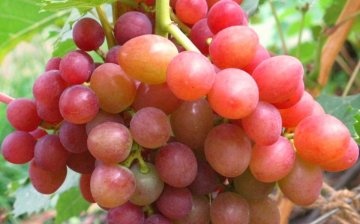


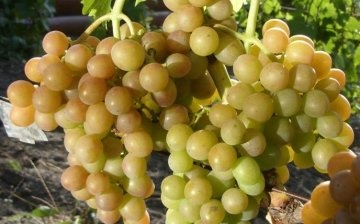




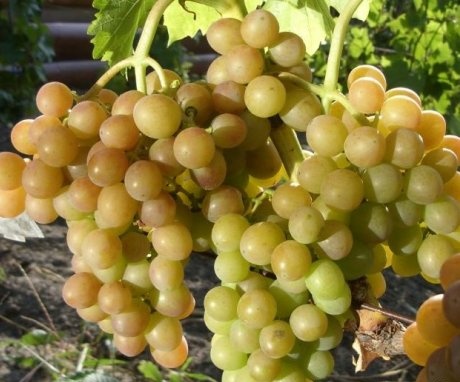
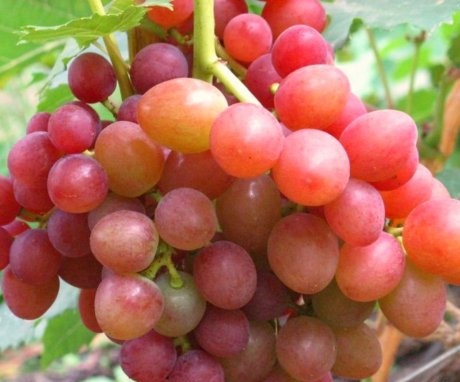
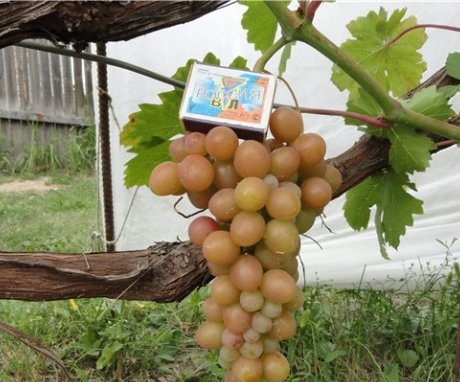

For the first time I hear about this variety, I was interested in the information, I am trying to get data on how it feels in our region, it seems to me that there should be no problems in this regard.
This variety has been growing in the Rostov region for quite some time. You need to plant the vine so that the trees do not cast a shadow on the grapes. In this case, the berries turn pinkish and even reddish, and taste much better than the green ones.
In my second year I got sick with something, I thought I would cut it off and throw it away, but closer to autumn I still began to recover. Last year, he had not yet yielded fruit, but he looked quite healthy and was well stretched. I am expecting a harvest this year, I will definitely sign off on the results. For the winter, this time, he carefully wrapped it up.
I love grapes very much and have tried to grow any kind. I can say that Shiny is really one of those species that do not require any special care, but at the same time I have a very good harvest for the third year.